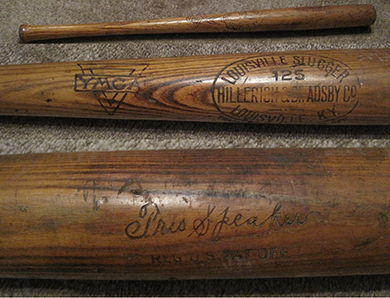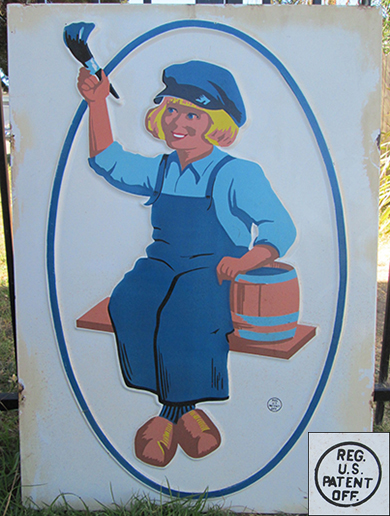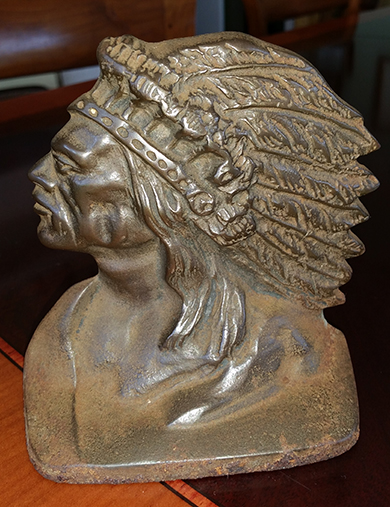 |
|
|||
 |
 |
|||
|
Copyright © Harry Rinker, LLC 2016 Questions
and Answers
QUESTION: I own a Hillerich & Bradsby baseball bat that is branded with a Tris Speaker signature. The bat is 35-inches in length. The circumference at its thickest point is 7 1/2 inches. The bat has three marks. The first is an oval containing “LOUISVILLE SLUGGER / 125 / HILLERICH & BRADSBY Co. / ---- • ---- / LOUISVILLE, KY.” To the left of the oval is the branded YMCA logo. To the right of the oval is “Tris Speaker” in script over “REG. U.S. PAT. OFF.” The bat belonged to my father who played baseball for a YMCA team in the early 1920s. What is my bat worth? – SF, Womelsdorf, PA 19567, Email Question 
ANSWER: Tristram Edgar Speaker (April 4, 1888 to December 8, 1958), also known as “The Grey Eagle,” began his baseball career playing for minor league teams in Texas and Arkansas. He joined the Boston Red Sox in 1907, helping the team win World Series Championships in 1912 and 1915. He was traded to the Cleveland Indians in 1916 and spent 11 years with the team. Speaker spent 1927 with the Washington Senators and 1928 with the Philadelphia Athletics. He was inducted into the Baseball Hall of Fame in 1937. Signature bats divide into two basic categories: (1) game-used bats and (2) endorsed bats sold to the general public. Your bat is from the second category. [Author’s Aside #1: I found two recorded sales for PSA/DNA graded Tris Speaker game used bats. One sold in 2006 for $34,846.00 and a second in 2014 for $27, 584.00. “What if my _-(object)__ was” stories are an integral part of the antiques and collectibles business.] When asked what the antiques and collectibles world sells, my stock answer is: “dreams, stories, and memories.” Your Tris Speaker bat has a wonderful back story. When America entered World War I in 1917, Clark Griffith, owner of the Washington Senators, led a drive to raise money to purchase athletic equipment, primarily baseball equipment, for use at military training camps. Hillerich & Bradsby and Spaulding, two major sports gear manufacturers, and the YMCA joined Griffith’s efforts. In addition to supplying U.S. training centers, the YMCA shipped 79,680 balls and 144,000 bats to troops stationed abroad. The YMCA branded bats were produced between 1917 and 1918. Bats contained the signatures of common players as well as signatures of star players such as Ty Cobb, George Sisler, and Joe Jackson. The bats were identical to the models used by the players. [See: http://keymancollectibles.com/bats/ymcalouisvillesluggerbat.htm] YMCA bats in very good or better condition for common players sell in the $150.00 to $250.00 range. I did not find a sell through record for a Tris Speaker 1917-18 YMCA bat. In March 2014 Mears Auction sold a “1920-1928 Tris Speaker 40K H & B Louisville Slugger Professional Model Game Bat” for $2,257. There were issues with the provenance attribution. Your bat is game used, not by Speaker but by your father. If sold at auction by a firm specializing in sports memorabilia, such as Hunt Auctions in Exton, Pennsylvania, your Tris Speaker bat should realize between $800.00 and $1,000.00. QUESTION: I have a cast iron Griswold ashtray. It has a square format with half cylinders for holding cigarettes in the upper left and right corners. There is a handle at the top. The bottom contains a device to hold a book of matches. The square body measures 3 1/2 inches. The overall length is 6 inches from the edge of the matchbox holder to the end of the handle. The ashtray is marked #770” on the bottom. I was not aware Griswold made ashtrays. What information can you provide? – SS, Bozman, MT, Email Question 
ANSWER: Matthew Griswold and his cousins J. C. and Samuel Selden founded the Selden-Griswold Manufacturing Company, located in Erie, Pennsylvania, in 1865. The company made hinges and other hardware products. By the 1870s, skillets and other household products entered the product line. In 1884, Matthew bought out his cousins. By the beginning of the 20th century, the company gained a national reputation for the quality of its cast iron cookware. Griswold began experiencing financial difficulty in the 1940s. In 1946, the family sold the company to an investment group. Numerous ownership changes followed. Manufacturing ceased in 1999 and the brands were acquired by American Culinary Corporation of Willoughby, Ohio. There are two varieties of Griswold ashtrays—the first with a square body and the second with a round body. The round body example has been reproduced. The round body reproductions do not have the match holder. Counterfeit (fake) examples are missing the cigarette rests and have a mark inside. I found no evidence that the square body ashtray was reproduced. I had difficulty dating your ashtray. One for sale listing suggested 1950s, a date that seems correct to me. The average asking price for Griswold square ashtrays ranged from $45.00 to $50.00. Asking is not getting. WorthPoint.com, an online price guide, features sell through prices. In checking WorthPoint’s Worthepedia, I found multiple sell through prices. Sale results ranged from $10.00 to $25.00, the higher price being the exception rather than the rule. A fair market price appears to be around $15.00. QUESTION: Fifteen years ago, I purchased a Dutch Boy Paints sign for $50.00 from a friend who was moving back east. The enamel sign measures 32-inches wide and 46-inches high. It has some condition issues such as fading and corrosion in some spots. WorthPoint.com has several similar signs listed but (1) they are smaller and (2) all have text on them. Is my sign period and what is its value? – SK, Richmond, CA, Email Question 
ANSWER: The National Lead Company created the Dutch Boy Paints brand in 1907. The brand’s name capitalized on the “Dutch Process” for producing paint that set quality and beauty standards for the industry. Lawrence Earle painted the initial artwork for the Dutch Boy logo using his nine-year old neighbor Michael E. Brady for the model. The Dutch boy image has been refreshed eight times. Sherwin Williams acquired the brand in 1980, two years after a ban on using lead in paint went into effect. The Dutch Boy Paints brand is headquartered in Cleveland, Ohio. [See: http://menards.dutchboy.com/about-us/] I also was unsuccessful in finding an exact example of your sign that sold on the secondary market. I did find a die-cut example of the same size missing the white exterior background of your sign. It sold for $900.00, which included the buyer’s penalty. The sign’s size is a plus. It is large, showy and decorative. The sign’s image matches the 1957 refreshment of the Dutch Boy logo. The age and wear characteristics also support a period attribution. The fading adds a mellowness to the image. I do not find the condition issues to be as critical as you suggest. As always, I recommend a conservative approach. The sign would sell quickly in an antiques mall or similar environment priced between $300.00 and $350.00. If sold at a specialized advertising auction, such as Richard Penn Auctions in Waterloo, Iowa, the final hammer price should exceed $500.00. QUESTION: I own a pair of cast metal, figural Indian head bookends. I believe the bookends are made from iron but the backside looks like brass. There are no markings on them. Can you provide an approximate manufacturing date? What are the bookends worth? – KP, Email Question 
ANSWER: The bookends could be cast bronze or a slush (white) metal with a painted finish. Cast iron also was used to manufacture bookends. Cast iron examples lack the detail of bronze and slush metal examples and usually are painted. Your bookends date from the 1930s. In researching figural Indian head bookends, I found more than a dozen different variations. I did find two sale listings for your bookends. Neither provided any suggestion about a possible manufacturer. [Author’s Aside #2: If a reader knows the maker of the two bookends, please email the information to me at harrylrinker@aol.com.] The value of your bookends is between $30.00 and $35.00. An eBay seller is asking $65.00. There were no buyers at this price. Harry L. Rinker welcomes questions from readers about
collectibles, those mass-produced items from the twentieth and twenty-first centuries.
Selected letters will be answered in this column.
Harry cannot provide personal answers.
Photos and other material submitted cannot be
returned.
Send your questions to: Rinker on Collectibles, 5955 Mill
Point Court SE, Kentwood, MI 49512.
You also can e-mail your questions to
harrylrinker@aol.com.
Only e-mails containing a full name and mailing address
will be considered.
You can listen
and participate in
WHATCHA GOT?, Harry’s
antiques and collectibles radio call-in show, on Sunday mornings between 8:00 AM
and 10:00 AM Eastern Time.
If you
cannot find it on a station in your area,
WHATCHA GOT?
streams live on the Internet at www.gcnlive.com.
SELL, KEEP OR TOSS?: HOW TO DOWNSIZE A HOME,
SETTLE AN ESTATE, AND APPRAISE PERSONAL PROPERTY
(House of Collectibles, an imprint of Random House Information Group, $17.99),
Harry’s latest book, is available at your favorite bookstore and via
www.harryrinker.com.
|
||||